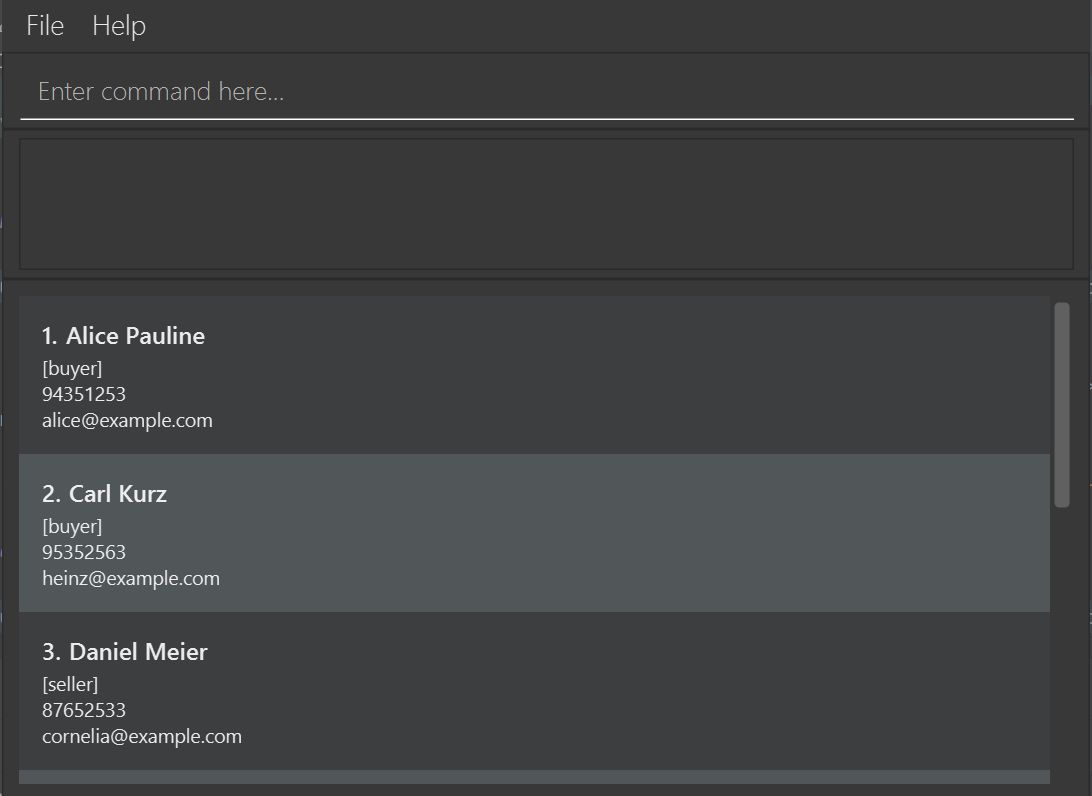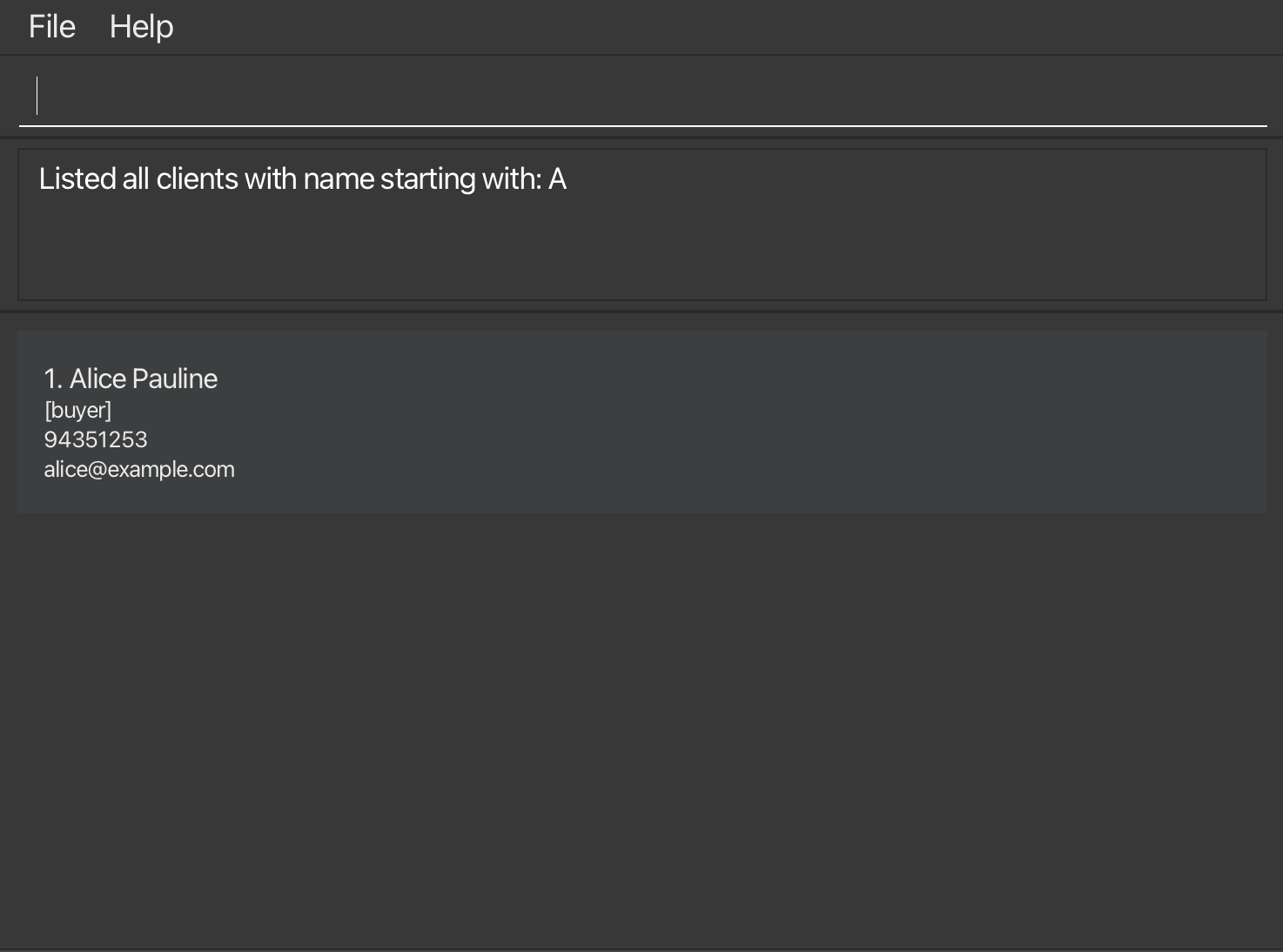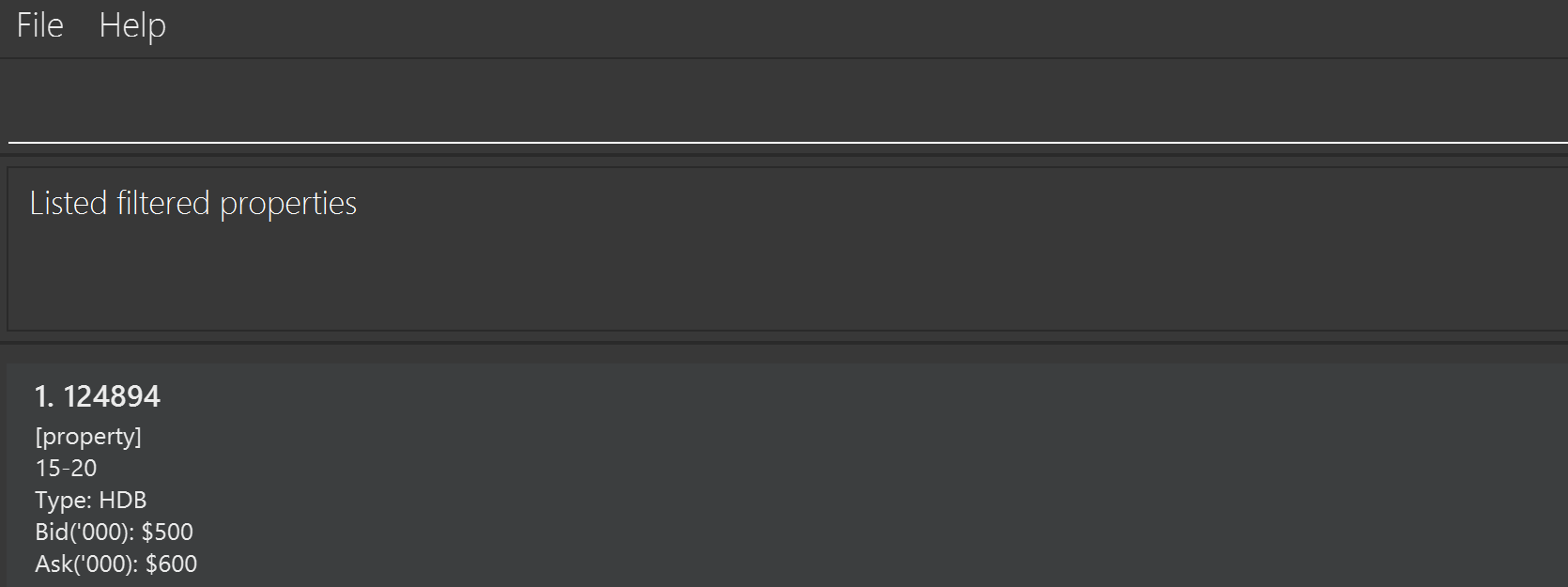ClientGrid User Guide
ClientGrid is an address book targeted for English-speaking real estate agents handling residential properties within Singapore. It is used to efficiently manage client contacts, properties and meeting schedule by providing a streamlined way to organize these data while maintaining core address book functionality. It is a desktop app optimized for fast user interactions through a Command Line Interface (CLI), while maintaining the user-friendly visual elements of a Graphical User Interface (GUI).
ClientGrid Context TL;DR:
- The app is designed specifically for the Singapore residential property market only.
- The default language of communication is English. Using other languages may produce errors or unexpected results.
- All monetary values are in Singapore Dollars (SGD) by default.
Quick start
Ensure you have Java 17 or above installed in your Computer. View this tutorial for Java 17 installation.
Download the latest
.jarfile from here.Copy the file to an empty folder that you want to use as the home folder for ClientGrid.
Open a command terminal.
In the command terminal, navigate into the folder you placed the jar file in using
cd. View this tutorial for using thecdcommand in your command terminal.Type the
java -jar clientGrid.jarcommand to run the application.
A GUI similar to the below should appear in a few seconds. Note how the app contains some sample data.

Type a command in the command box and press Enter to execute it. For example, typing
helpand pressing Enter will open the help window. Refer to the Features below for details of each command and the Command Summary for a quick overview of all the commands.
Features
Notes about the command format:
All the commands in ClientGrid (e.g.
list,addbuyer,addproperty,addmeeting, etc.) are case-sensitive and must be entered in lower case.Words in
UPPER_CASEare the parameters to be supplied by the user.
e.g. Inaddbuyer n/BUYER_NAME p/BUYER_PHONE_NUMBER e/BUYER_EMAIL,BUYER_NAME,BUYER_PHONE_NUMBERandBUYER_EMAILare parameters which can be used asaddbuyer n/John p/81234567 e/john@gmail.com.Parameters in square brackets are optional.
e.g.t/TYPE [lte/MATCHING_PRICE]can be used ast/HDB lte/300ort/HDB.Parameters can be in any order.
e.g. If the command specifiesn/BUYER_NAME e/BUYER_EMAIL p/BUYER_PHONE_NUMBER,e/BUYER_EMAIL p/BUYER_PHONE_NUMBER n/BUYER_NAMEis also acceptable.Extraneous parameters for commands that do not take in parameters (such as
helpandexit) will be ignored.
e.g. If the command specifieshelp 123, it will be interpreted ashelp.If you are using a PDF version of this document, be careful when copying and pasting commands that span multiple lines as space characters surrounding line-breaks may be omitted when copied over to the application.
Viewing help : help
Shows a message explaning how to access the help page.
Format: help
Listing ClientGrid records : list
Shows a list of all existing buyers, sellers, clients (i.e. buyers and sellers), properties, or meetings in ClientGrid.
Format: list k/KEY
The
listcommand displays records based on the specifiedKEY.The
KEYmust be one of the following:buyers,sellers,clients,properties, ormeetings.buyers: Lists all buyers in the client book.sellers: Lists all sellers in the client book.clients: Lists all clients (i.e. buyers and sellers combined) in the client book.properties: Lists all properties in the property book.meetings: Lists all meetings in the meeting book.
If an invalid
KEYis provided, an error message will be displayed.
The KEY is case-insensitive and ignores leading and trailing spaces.
Examples:
Adding a buyer : addbuyer
Adds a specified buyer into the client book of ClientGrid.
Format: addbuyer n/BUYER_NAME p/BUYER_PHONE_NUMBER e/BUYER_EMAIL
- Adds a buyer with the specified
BUYER_NAME,BUYER_PHONE_NUMBER, andBUYER_EMAIL. - The
BUYER_NAMEmust not be empty. Each word is separated by a single space or apostrophe and has a character limit of 747 (longest name in the world is 747 characters). - The
BUYER_PHONE_NUMBERshould only contain 8 digits in the range [0-9] and can only start with '3', '6', '8' or '9' (as per the format for Singapore phone numbers). Spaces are not allowed between the 8 digits. - The
BUYER_EMAILshould be of the formatlocal-part@domainand adhere to the following constraints:- The
local-partshould only contain alphanumeric characters and these special characters:+,_,.,-.- The
local-partmay not start or end with any special characters and must not contain consecutive special characters.
- The
- This is followed by an
@and then adomain. - The
domainmust:- Consist of one or more domain labels separated by a single period.
- Each domain label must start and end with alphanumeric characters.
- The final label is the top-level domain (TLD), which must be at least two alphabetic characters long.
- Consist of one or more domain labels separated by a single period.
- Examples:
example@gmail.com,example@u.nus.edu.
- The
Duplicate Buyers And Emails
- Duplicate buyers: No duplicate buyers are allowed. They are checked based on whether there is an existing buyer with the same phone number in the client book.
- Duplicate emails: No duplicate emails are allowed. Duplicate emails are detected if:
- There is a buyer with the same email already in the client book.
- There is a seller with the same email but a different phone number in the client book. Having the same email address as an existing seller with a different phone number is not allowed as emails should be unique to a client.
Special Scenario: It's possible to have a buyer and seller with the same phone number but different names/emails. This flexibility provided by ClientGrid allows users to record the same client under different names/emails in buying and selling roles, which may be useful for clients operating under separate business identities (e.g. personal vs. professional roles).
Examples:
addbuyer n/John p/83456789 e/john@gmail.comadds a buyer whose name isJohn, phone number is83456789and email isjohn@gmail.com.
Adding a seller : addseller
Adds a specified seller into the client book of ClientGrid.
Format: addseller n/SELLER_NAME p/SELLER_PHONE_NUMBER e/SELLER_EMAIL
- Adds a seller with the specified
SELLER_NAME,SELLER_PHONE_NUMBER, andSELLER_EMAIL. - The restrictions for the
SELLER_NAME,SELLER_PHONE_NUMBERandSELLER_EMAILare identical to the restrictions for theBUYER_NAME,BUYER_PHONE_NUMBERandBUYER_EMAILrespectively as specified in theaddbuyercommand.
Duplicate Sellers And Emails: For seller-specific restrictions, please refer to the addbuyer command. The same rules apply, including:
- Duplicate Sellers: No duplicate sellers are allowed. A duplicate seller is defined as one with the same phone number as an existing seller.
- Duplicate Emails: No duplicate emails are allowed, following the same logic as the
addbuyercommand:- A seller cannot share the same email as another seller.
- A seller cannot have the same email as a buyer with a different phone number. Email uniqueness is enforced per client.
The Special Scenario also applies here: you can have a buyer and seller with the same phone number but different names/emails, allowing flexibility for clients who operate under different names/emails in buying and selling roles.
Examples:
addseller n/Mary p/83456789 e/mary@gmail.comadds a seller whose name isMary, phone number is83456789and email ismary@gmail.com.
Filtering clients : filterclient
Filters the clients that starts with the prefix (case-insensitive) provided.
Format: filterclient n/NAME
- Filters existing client with the specified prefix
NAME. - The restrictions for the
NAMEis identical to the restrictions for theBUYER_NAMEspecified in theaddbuyercommand.
Examples:
Deleting a buyer : deletebuyer
Deletes the specified existing buyer from the client book of ClientGrid.
Format: deletebuyer p/BUYER_PHONE_NUMBER
- Deletes the buyer with the specified
BUYER_PHONE_NUMBER. - The restrictions for the
BUYER_PHONE_NUMBERis identical to the restrictions for theBUYER_PHONE_NUMBERspecified in theaddbuyercommand.
Examples:
Deleting a seller : deleteseller
Deletes the specified existing seller from the client book of ClientGrid.
Format: deleteseller p/SELLER_PHONE_NUMBER
- Deletes the seller with the specified
SELLER_PHONE_NUMBER. - The restrictions for the
SELLER_PHONE_NUMBERis identical to the restrictions for theBUYER_PHONE_NUMBERspecified in theaddbuyercommand.
Examples:
Adding a property : addproperty
Adds a specified property into the property book of ClientGrid.
Format: addproperty c/POSTAL_CODE u/UNIT_NUMBER t/TYPE a/ASK b/BID
- Adds a property of
TYPEwith the specifiedPOSTAL_CODEandUNIT_NUMBERwith seller's estimatedASKprice (in thousands) and buyer's estimatedBIDprice (in thousands). - The
POSTAL_CODEmust be a non-negative integer and contain exactly 6 numeric characters. - The
UNIT_NUMBERmust contain numbers delimited by a dash, and numbers on either side of the dash must be at least 2 characters long with no excess padding. The range of numbers on the left hand side of the dash is [00-148] and the right hand side is [00-111110]. - The
TYPEmust be one of the following values (case-insensitive):HDB,CONDO, orLANDED. - The
ASKmust be a non-negative integer smaller than 1,000,000 (thousand) with only numeric characters. - The
BIDmust be a non-negative integer smaller than 1,000,000 (thousand) with only numeric characters.
Duplicate Properties: No duplicate properties are allowed. Duplicate properties are checked based on:
- if at least one of the two properties are
LANDED, then the comparison is done based on postal code. - if one property is a
CONDOand one property is aHDB, then the comparison is done based on postal code. - if the two properties are both
CONDOor are bothHDB, then the comparison is done based on postal code and unit.
Unit Defaults:
The UNIT_NUMBER parameter for LANDED properties will default to 00-00 regardless of the value placed. This is because a landed property is not segmented into multiple apartments and therefore, deemed to be a unit in itself.
Padding In Unit:
ClientGrid follows Singapore’s convention of padding unit numbers with 0. Single-digit numbers require a leading 0 (e.g. 08-12 instead of 8-12).
For numbers with two or more non-zero digits, avoid extra padding with 0 (e.g. 18-12 instead of 018-12).
Ask And Bid Prices:
Since property prices in Singapore typically start in the thousands, Ask and Bid prices will be calculated in increments of $1 (thousand) to provide agents with a quick estimated value without focusing on smaller denominations. Therefore, prices less than $1 (thousand) will round down to $0 (thousand) as any smaller denominations are considered negligible.
Examples:
addproperty c/124894 u/15-20 t/HDB a/600 b/500adds a property with postal code124894and unit number#15-20whose type is aHDBwith an ask price of$600 (thousand)and bid price of$500 (thousand).
Filtering properties : filterproperty
Filters existing properties based on any combination of type, lower bound for matching price and upper bound for matching price.
Format: filterproperty [t/TYPE] [gte/MATCHING_PRICE] [lte/MATCHING_PRICE]
- Filters the properties with any combination of
TYPE, lower boundedMATCHING_PRICEand upper boundedMATCHING_PRICE. - The
TYPEis case-insensitive:HDB,CONDOorLANDED. - The
MATCHING_PRICEmust be a non-negative integer smaller than 1,000,000 (thousand) with only numeric characters.
Defining Parameter Abbreviations
gte/: Means greater than or equal. Sets the lower bound, filtering values greater than and including the specified number.
lte/: Means lesser than or equal. Sets the upper bound, filtering values less than and including the specified number.
Important
- At least one optional prefix needs to be present for any filtering to be possible.
- Prices denoted in
gte/andlte/parameters are checked based on the 'AND' condition. For example,filterproperty gte/500 lte/60000filters for properties greater than or equal to$500 (thousand)and less than or equal to$60,000 (thousand). - The filter feature allows flexibility in custom price searches and hence, delivers results on a best effort basis. Thus, an input such as
filterproperty gte/600 lte/500will simply not return any results.
Examples:
filterproperty t/HDB gte/400 lte/700filters and lists properties which is typeHDBand matching price is greater than or equal to$400 (thousand)and less than or equal to$700 (thousand).
Deleting a property : deleteproperty
Deletes a specified existing property from the property book of ClientGrid.
Format: deleteproperty c/POSTAL_CODE u/UNIT_NUMBER
- Deletes a property with the specified
POSTAL_CODEandUNIT_NUMBER. - The restrictions for the
POSTAL_CODEandUNIT_NUMBERare identical to the restrictions for thePOSTAL_CODEandUNIT_NUMBERspecified in theaddpropertycommand.
Examples:
Adding a meeting : addmeeting
Adds a specified meeting to the meeting book of ClientGrid.
Format: addmeeting mt/MEETING_TITLE d/MEETING_DATE bp/BUYER_PHONE sp/SELLER_PHONE t/TYPE c/POSTAL_CODE
- Adds a meeting with the specified
MEETING_TITLEandMEETING_DATE, including the providedBUYER_PHONE,SELLER_PHONE, as well as thePOSTAL_CODEandTYPEof the property involved. - The
MEETING_TITLEshould only contain alphanumeric characters and spaces. It should not be blank (or contain only whitespaces) and it should not exceed 100 characters (excluding starting and ending whitespaces). - The
MEETING_DATEshould be in the format dd-MM-yyyy and must be a valid date that is today or in the future. - The restrictions for the
BUYER_PHONEandSELLER_PHONEare identical to the restrictions for theBUYER_PHONE_NUMBERspecified in theaddbuyercommand. - The restrictions for the
POSTAL_CODEandTYPEare identical to the restrictions for thePOSTAL_CODEandTYPEspecified in theaddpropertycommand.
Duplicate Meetings:
- To avoid duplicate entries for meetings on the same day, each meeting in the meeting book must have a unique combination of
MEETING_TITLEandMEETING_DATE. - Note that
MEETING_TITLEis case-sensitive, so titles likemeeting 1andMEETING 1are treated as distinct.
Note:
BUYER_PHONErefers to a buyer's phone number. There must be an existing buyer in the client book that has a phone number that is equal to theBUYER_PHONE.SELLER_PHONErefers to a seller's phone number. Likewise, there must be an existing seller in the client book with a phone number equal toSELLER_PHONE.POSTAL_CODErefers to a postal code. The postal code must belong to some existing property in the property book of the specifiedTYPE.
Examples:
addmeeting mt/Meeting 1 d/01-01-2025 bp/95352563 sp/87652533 t/HDB c/123456adds a meeting with meeting titleMeeting 1, meeting date01-01-2025, buyer's phone number95352563, seller's phone number87652533, property typeHDBand postal code321456.
Deleting a meeting : deletemeeting
Deletes a specified existing meeting from the meeting book of ClientGrid.
Format: deletemeeting mt/MEETING_TITLE d/MEETING_DATE
- Deletes a meeting with the specified
MEETING_TITLEandMEETING_DATE. - The restrictions for the
MEETING_TITLEandMEETING_DATEare identical to the restrictions for theMEETING_TITLEandMEETING_DATEspecified in theaddmeetingcommand.
MEETING_TITLE is case-sensitive, so to delete a meeting, the title must be specified with the exact same casing as the original entry.
Examples:
deletemeeting mt/Meeting 1 d/01-01-2025deletes a meeting with meeting titleMeeting 1and meeting date01-01-2025.
Exiting the program : exit
Exits the program.
Format: exit
Saving the data
ClientGrid data are saved in the hard disk automatically after any command that changes the data. There is no need to save manually.
Editing the data file
Client, meeting, and property data are automatically saved as separate JSON files in [JAR file location]/data/:
clientbook.jsonfor client (i.e. buyers and sellers) entriesmeetingbook.jsonfor meeting entriespropertybook.jsonfor property entries
📁 [JAR file location]
└── 📁 data
├── clientbook.json
├── meetingbook.json
└── propertybook.json
Advanced users are welcome to directly update data by editing these individual files in the data directory.
Caution:
If your changes to the data files make its format invalid, ClientGrid will discard all data and start with an empty data file at the next run. Hence, it is recommended to take a backup of the file before editing it.
Furthermore, certain edits can cause ClientGrid to behave in unexpected ways (e.g. if a value entered is a restriction as defined in the commands above). Therefore, users are cautioned to only edit the data files if they are confident that you can update it correctly.
FAQ
Q: Can buyers and sellers have the same phone number?
A: Yes. A single client can be both a buyer and a seller of properties and can use the same phone number in both roles. However, two different buyers or two different sellers cannot share the same phone number.
Known issues
- When using multiple screens, if you move the application to a secondary screen, and later switch to using only the primary screen, the GUI will open off-screen. The remedy is to delete the
preferences.jsonfile created by the application before running the application again.
Glossary
- Alphanumeric: Refers to characters that are either letters (
A-Z,a-z) or numbers (0-9). - CLI (Command Line Interface): A text-based interface that allows users to interact with a software application by typing commands.
- Domain: The portion of the email address after the
@symbol. - Domain label: A subdivision of the domain name, separated by periods (e.g.
gmailandcomingmail.com). - GUI (Graphical User Interface): A visual interface that allows users to interact with a software application through visual elements such as buttons, icons, menus, and windows, instead of text-based commands.
- Local-part: The portion of the email address before the
@symbol. - Matching price: The estimated price of the property given by the average of the property's lowest
ASKprice and highestBIDprice. - Top-level domain (TLD): The last part of the domain name, such as
com,org, oredu. It generally indicates the type or location of the organization.
Command summary
| Action | Format |
|---|---|
| Help | help |
| List | list k/KEY |
| Add Buyer | addbuyer n/BUYER_NAME p/BUYER_PHONE_NUMBER e/BUYER_EMAIL |
| Add Seller | addseller n/SELLER_NAME p/SELLER_PHONE_NUMBER e/SELLER_EMAIL |
| Filter Clients | filterclient n/NAME |
| Delete Buyer | deletebuyer p/BUYER_PHONE_NUMBER |
| Delete Seller | deleteseller p/SELLER_PHONE_NUMBER |
| Add Property | addproperty c/POSTAL_CODE u/UNIT_NUMBER t/TYPE a/ASK b/BID |
| Filter Properties | filterproperty [t/TYPE] [gte/MATCHING_PRICE] [lte/MATCHING_PRICE] |
| Delete Property | deleteproperty c/POSTAL_CODE u/UNIT_NUMBER |
| Add Meeting | addmeeting mt/MEETING_TITLE d/MEETING_DATE bp/BUYER_PHONE sp/SELLER_PHONE t/TYPE c/POSTAL_CODE |
| Delete Meeting | deletemeeting mt/MEETING_TITLE d/MEETING_DATE |
| Exit | exit |











